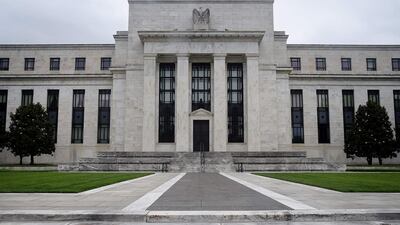US Federal Reserve officials held interest rates near zero but signalled they expect two increases by the end of 2023, pulling forward the date of lift-off as the economy recovers.
Officials sped up their expected pace of policy tightening amid optimism about the labour market and heightened concerns for inflation.
Fed Chair Jerome Powell told a press conference Wednesday after a meeting with officials that they would begin a discussion about scaling back bond purchases used to support financial markets and the economy during the pandemic.
New forecasts were released showing two interest-rate increases expected by the end of 2023 — sooner than many thought — and upgraded estimates for inflation for the next three years.
“The economy has clearly made progress,” Mr Powell said after the two-day gathering.
“You can think of this meeting as the talking-about-talking-about meeting, if you like,” he added, referring to the discussion about tapering purchases.
The central bank held the target range for its benchmark policy rate unchanged at zero to 0.25 per cent – where it has been since March 2020 – and pledged to continue asset purchases at a $120 billion monthly pace until “substantial further progress” had been made on employment and inflation.
The quarterly projections showed 13 of 18 officials favoured at least one rate increase by the end of 2023, versus seven in March.
Eleven officials saw at least two increases by the end of that year, while seven of them saw a move as early as 2022, up from four.
“The dots should be taken with a big grain of salt,” Mr Powell said, referring to the interest rate forecasts. He cautioned that discussions about raising rates would be “highly premature".
The dollar rose, stocks declined and yields on 10-year Treasuries jumped following the news.
The US economic recovery is gathering strength as business restrictions lift and social activity increases across the country.
“Progress on vaccinations has reduced the spread of Covid-19 in the United States,” the Federal Open Market Committee said in a statement.
“Amid this progress and strong policy support, indicators of economic activity and employment have strengthened.”
Robust demand from consumers and businesses alike has outstripped capacity, leading to bottlenecks in the supply chain, longer lead times and higher prices. At the same time, employment growth has disappointed over the past couple of months.
The Fed marked up its inflation forecasts through the end of 2023. Officials see their preferred measure of price pressures rising 3.4 per cent in 2021 compared with a March projection of 2.4 per cent. The 2022 forecast rose to 2.1 per cent from 2 per cent, and the 2023 estimate was raised to 2.2 per cent from 2.1 per cent.
Consumer-price pressures, on the other hand, have proven hotter than expected. Labour Department figures showed a 0.8 per cent jump in prices in April and a 0.6 per cent rise in May, marking the two biggest monthly increases since 2009.
“As the reopening continues, shifts in demand can be large and rapid, and bottlenecks, hiring difficulties and other constraints could continue to limit how quickly supply can adjust – raising the possibility that inflation could turn out to be higher and more persistent than we expect,” Mr Powell said.
Labour Department reports on employment published since the last gathering of the US central bank’s committee in late April have disappointed relative to forecasters’ expectations.
The US unemployment rate was still elevated at 5.8 per cent in May, with total employment still millions of jobs below pre-pandemic levels.
“I am confident that we are on a path to a very strong labour market,” Mr Powell told reporters. “We learnt during the course of the last very long expansion, the longest in our history, that labour supply during a long expansion can exceed expectations.”

